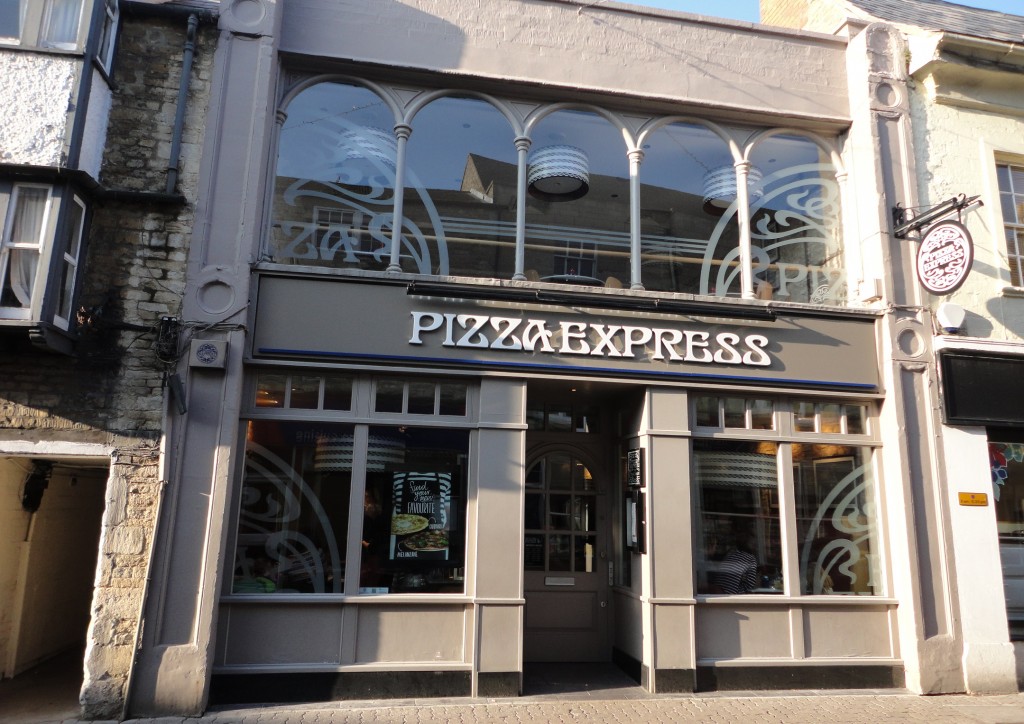The UK’s ubiquitous pizza chain tells you several things about Britain, including its liking for classy interiors, discount vouchers and consistent, comforting food. It can be worth bringing earplugs though.
First published on Beacon.
Britain has a well-established Italian community. Many have run family businesses, such as restaurants, for decades. One of the barbers in your correspondent’s town, who was born in Italy but came to Britain as a child, took over the business from his father; his British-born son now works beside him, in the premises they have occupied for more than half a century. Some of the British children of Italian immigrants have become famous, such as the lead singer of Texas Sharleen Spiteri and Doctor Who and Thick of It actor Peter Capaldi.
PizzaExpress has pretty much nothing to do with British-Italians. It was founded by Peter Boizot, a son of Peterborough, a vegetarian who ate his first pizza at the age of 19 when tutoring an Italian family. After graduating from Cambridge University, he worked in various European cities and ended up working for Associated Press in Rome. When he returned to London in 1964, he found he couldn’t get a decent pizza. So in 1965, he opened the first PizzaExpress in Soho. It’s a British enthusiast’s version of Italian food (with excellent vegetarian options) as a result.
There are now more than 430 PizzaExpresses in Britain, with 70 more in 13 other countries. It’s a chain restaurant, but not like most others. Most go for consistency, the same experience everywhere. PizzaExpress uses a common menu, but served in an extraordinarily physically diverse set of branches. This makes sense in Britain, where it’s hard to construct new buildings. Many chains try to fight this and homogenise the spaces they rent, not always terribly well. PizzaExpress uses the variety as a strength.
Perhaps its grandest branch is in Cambridge, at 7a Jesus Lane – so upmarket it doesn’t even have a sign. The building, originally designed as a Victorian Roman bath, is owned by the University Pitt Club, a private men-only member’s club which has been there since 1866. PizzaExpress took over the ground floor in the early 1990s, and signed a 25-year lease in 1997. The Pitt Club is now confined to the upstairs of the building.
Diners get to sit in two fabulously posh rooms, one looking like a club library (for obvious reasons), the other more like a conservatory in Downton Abbey. It’s like eating in the posh rooms of a National Trust mansion (instead of the stables, which is where the National Trust usually put the café). Nevertheless, 7a uses the chain’s standard menu and its modest prices.
I came, I saw, I ate dough balls

PizzaExpress in Cirencester, a Roman town in the Cotswolds, is not quite as grand but still has its own distinctive points. The interior exposes the building’s Cotswold stone walls, and has wall-lights in the shape of polo hats along with other equestrian motifs, nodding to the area’s polo tradition.
And like many other branches, on Sunday lunchtimes it serves as Cirencester’s training ground for middle-class children whose parents want to induct them into acceptable restaurant behaviour. Cotswold stone looks lovely; and here’s a chance to appreciate its excellent ability to reflect high-pitched sound.
For those who can handle the youthful squealing, PizzaExpress also provides the chance to assess the state of the British economy. Strictly speaking, you don’t even have to dine there, just check to see what discounts branches are offering. If there aren’t any, Britain is booming. Over recent years, a discount of about £7 from a couple’s bill has been pretty standard. Last Sunday’s voucher cut £11 off the price of three courses and a drink each, to £34 ($53). That economic recovery still has a way to go, then.
Leaving aside everything else, what is the food like? It’s comfort food on a diet, basically. Everything served by PizzaExpress features straightforward flavours, the food equivalent of an easy-drinking Merlot. (PizzaExpress wines are easy drinking as well, and yes, the list includes two Merlots from Sicily, one a rosé.)
The pizzas are on thin bases, with a low calorie ‘Leggera’ option which cuts out pizza middle and replaces it with some salad. Its famous dough ball starter – little golf-ball sized blobs of pizza dough with garlic butter – are both delicious and fairly insubstantial. There’s a range of mini-desserts served with coffee. It works for both middle-class children, and parents trying to watch their weight.
PizzaExpress is as British as Balti curry (south Asian food re-invented in Birmingham). The chain provides a consistent service all over the country, rather like Premier Inns, but retains a dash of style through the custom interiors and reminders of its Soho roots, with the initial restaurant doubling up as a jazz venue.
It’s become part of national life: during the 1990s, as PizzaExpress went from just 12 outlets to 250, its arrival in a town or a city neighbourhood was a sign the area was on the up, along with local property prices. It has been the subject of arguments over whether it has shrunk the diameter of its pizzas – although as generations of Brits have eaten them as children, it is possible that we just grew up. (The chain apparently increased the diameter in 2002.)
This July, PizzaExpress was bought for £900m by a Chinese private equity firm, which plans to build on its 10 branches in mainland China. Inspired by continental Europe, housed in a lot of nice buildings, built on style and reliability rather than adventurousness and now owned by the Chinese: that’s fairly British.
